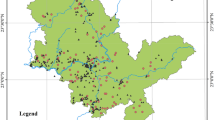Abstract
Conventional methods of spatial prediction, such as Kriging, require assumptions such as stationarity and isotropy, which are not easy to evaluate, and often do not hold for spatial data. For these methods, the spatial dependency structure between data should be accurately modeled, which requires expert knowledge in spatial statistics. On the other hand, spatial prediction using artificial neural network (ANN) has attracted considerable interest due to ANN’s ability in learning from data without the need for complex and specialized assumptions. However, ANN models require suitable input variables for better and efficient spatial prediction. This paper aims to improve the accuracy of ANNs spatial prediction using neighboring information. Given the general principle that ”closer spatial data are more dependent”, we tried to somehow enter data dependency into the network by using the neighboring observations. We proposed a hybrid model of ANN and inverse distance weighting, based on nearby observations. We also proposed an ANN-based model for spatial prediction based on weighted values of nearby observations. The accuracy of the models was compared through a simulation study. The results showed that using neighboring information to train ANN, dramatically increases the prediction accuracy.





Similar content being viewed by others
References
Appelhans T, Mwangomo E, Hardy DR, Hemp A, Nauss T (2015) Evaluating machine learning approaches for the interpolation of monthly air temperature at mt. Kilimanjaro, Tanzania. Spat Stat 14:91–113
Bishop CM (1995) Neural networks for pattern recognition. Oxford University Press, Oxford
Bishop CM (2006) Pattern recognition and machine learning. Springer-Verlag, New York
Chowdhury M, Alouani A, Hossain F (2010) Comparison of ordinary kriging and artificial neural network for spatial mapping of arsenic contamination of groundwater. Stoch Env Res Risk Assess 24(1):1–7
Chung C-H, Chiang Y-M, Chang F-J, Toth E (2012) A spatial neural fuzzy network for estimating pan evaporation at ungauged sites. Hydrol Earth Syst Sci 16(1)
Cressie N (2015) Statistics for spatial data. John Wiley and Sons, New Jersey
Deligiorgi D, Philippopoulos K (2011) Spatial interpolation methodologies in urban air pollution modeling: application for the greater area of metropolitan Athens, Greece. Adv Air Pollut pp 341–362
Diggle PJ, Ribeiro PJ (2007) Model-based Geostatistics. Springer Series in Statistics
Dubois G (1998) Spatial interpolation comparison 97: foreword and introduction. J Geogr Inf Decis Anal 2(2):1–10
Hristopulos DT (2020) Random fields for spatial data modeling: a primer for scientists and engineers. Springer Nature, Berlin
Kanevsky M, Arutyunyan R, Bolshov L, Demyanov V, Maignan M (1996) Artificial neural networks and spatial estimation of chernobyl fallout. Geoinformatics 7(1–2):5–11
Koike K, Matsuda S, Gu B (2001) Evaluation of interpolation accuracy of neural kriging with application to temperature-distribution analysis. Math Geol 33(4):421–448
Kuhn M (2021) caret: Classification and Regression Training. R package version 6.0-88
Li Z (2021) An enhanced dual idw method for high-quality geospatial interpolation. Sci Rep 11(1):1–17
Li Z, Wang K, Ma H, Wu Y (2018) An adjusted inverse distance weighted spatial interpolation method. In: Proceedings of the 2018 3rd international conference on communications, information management and network security (CIMNS 2018)
Li Z, Zhang X, Zhu R, Zhang Z, Weng Z (2020) Integrating data-to-data correlation into inverse distance weighting. Comput Geosci 24(1):203–216
Lin G-F, Chen L-H (2004) A spatial interpolation method based on radial basis function networks incorporating a semivariogram model. J Hydrol 288(3–4):288–298
Lin L (1989) A concordance correlation coefficient to evaluate reproducibility. Biometrics 45(1):255–268
Matheron G (1963) Principles of geostatistics. Econ Geol 58(8):1246–1266
Miller HJ (2004) Tobler’s first law and spatial analysis. Ann Assoc Am Geogr 94(2):284–289
Nevtipilova V, Pastwa J, Boori MS, Vozenilek V (2014) Testing artificial neural network (ann) for spatial interpolation. J Geol Geophys 3(2):01–09
Ojha VK, Abraham A, Snášel V (2017) Metaheuristic design of feedforward neural networks: a review of two decades of research. Eng Appl Artif Intell 60:97–116
Ribeiro Jr, PJ, Diggle PJ, Schlather M, Bivand R, Ripley B (2020) geoR: Analysis of Geostatistical Data. R package version 1.8-1
Ripley BD (2007) Pattern recognition and neural networks. Cambridge University Press, Cambridge
Rodriguez PP, Gianola D (2020) brnn: Bayesian Regularization for Feed-Forward Neural Networks. R package version 8
Rumelhart DE, Hinton GE, Williams RJ (1986) Learning representations by back-propagating errors. Nature 323(6088):533–536
Seo Y, Kim S, Singh VP (2015) Estimating spatial precipitation using regression kriging and artificial neural network residual kriging (rknnrk) hybrid approach. Water Resour Manage 29(7):2189–2204
Shepard D (1968) A two-dimensional interpolation function for irregularly-spaced data. In: Proceedings of the 1968 23rd ACM national conference, pp 517–524
Soares SAF, Neto GS, Roisenberg M (2016) Improving the incremental gaussian mixture neural network model for spatial interpolation and geostatistical simulation. In: 2016 international joint conference on neural networks (IJCNN), pp 2507–2514. IEEE
Tavassoli A, Waghei Y, Nazemi A (2021) Comparison of kriging and artificial neural network models for the prediction of spatial data. J Stat Comput Simul pp 1–18
Tobler WR (1970) A computer movie simulating urban growth in the detroit region. Econ Geogr 46(sup1):234–240
Wang H, Guan Y, Reich B (2019) Nearest-neighbor neural networks for geostatistics. In: 2019 international conference on data mining workshops (ICDMW), pp 196–205. IEEE
Webster R, Oliver MA (2007) Geostatistics for environmental scientists. John Wiley and Sons, Chichester
Yeh I-C, Huang K-C, Kuo Y-H (2013) Spatial interpolation using mlp-rbfn hybrid networks. Int J Geogr Inf Sci 27(10):1884–1901
Zimmerman DL, Zimmerman MB (1991) A comparison of spatial semivariogram estimators and corresponding ordinary kriging predictors. Technometrics 33(1):77–91
Author information
Authors and Affiliations
Corresponding author
Additional information
Publisher's Note
Springer Nature remains neutral with regard to jurisdictional claims in published maps and institutional affiliations.
Rights and permissions
About this article
Cite this article
Tavassoli, A., Waghei, Y. & Nazemi, A. Hybrid MLP-IDW approach based on nearest neighbor for spatial prediction. Comput Stat 37, 1943–1962 (2022). https://doi.org/10.1007/s00180-021-01186-0
Received:
Accepted:
Published:
Issue Date:
DOI: https://doi.org/10.1007/s00180-021-01186-0




